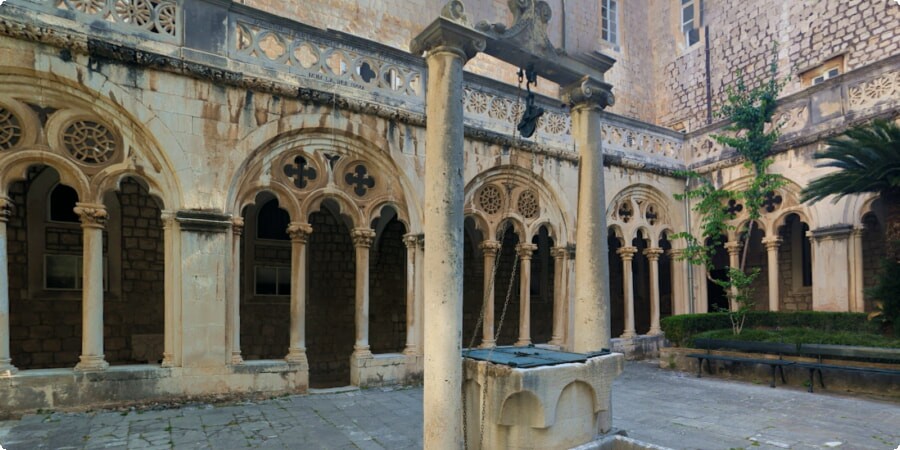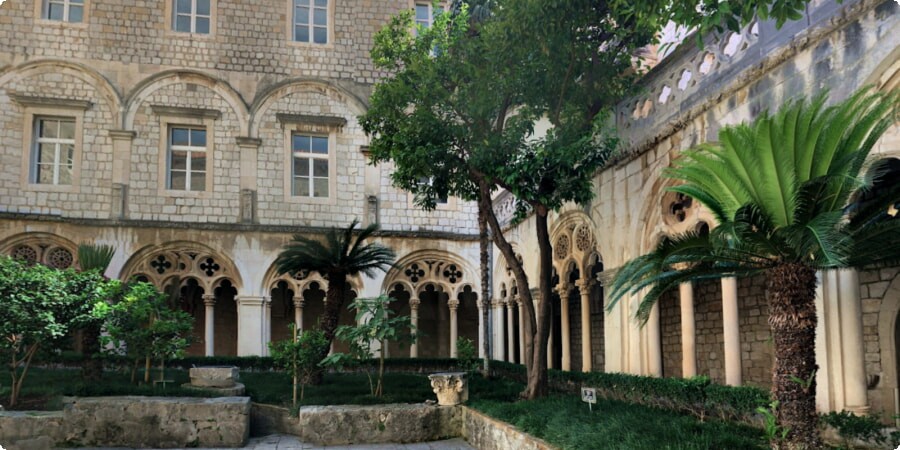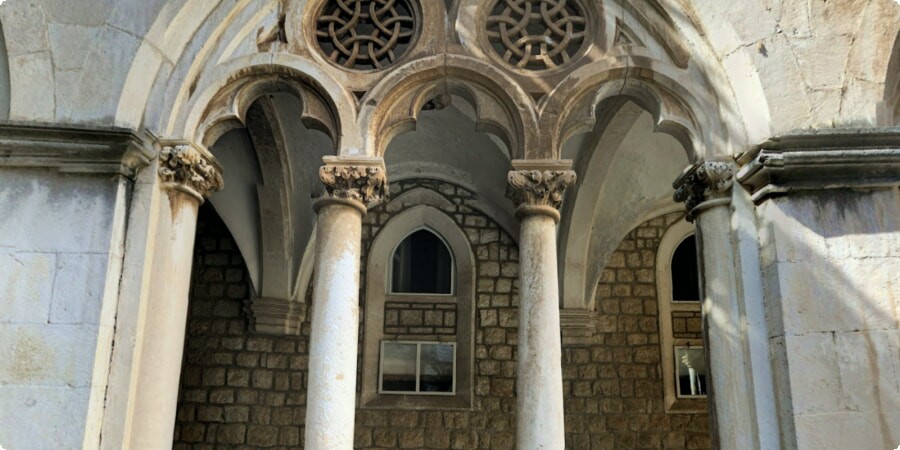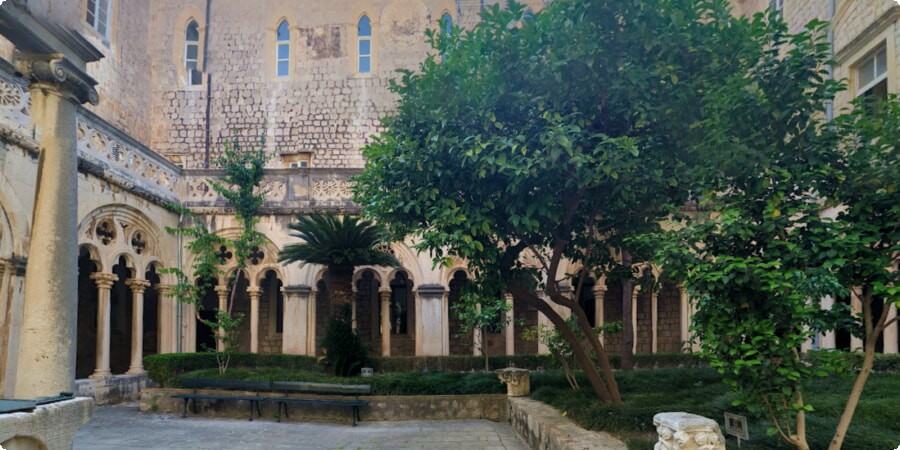The Dominican Monastery: A Sanctuary of Peace in Dubrovnik
Tucked away in the heart of Dubrovnik, the Dominican Monastery stands as a serene sanctuary amidst the bustling streets of this historic city. Founded in the early 14th century, this monastery is not only a place of spiritual retreat but also a treasure trove of art and history. As you step through its ancient doors, you are transported back in time, walking the same paths that monks and scholars have tread for centuries. The monastery's tranquil atmosphere offers a peaceful respite from the busy tourist spots, making it a must-visit for anyone exploring Dubrovnik.
Historical Background
The Dominican Monastery in Dubrovnik was established in 1315, a period marked by significant growth and development in the city. The Dominican Order, known for its commitment to education and preaching, played a crucial role in the intellectual and spiritual life of Dubrovnik. The monastery quickly became a center of learning and piety, attracting scholars and theologians from across the region.
Over the centuries, the monastery has witnessed and withstood numerous historical events, from the devastating earthquake of 1667 that reshaped Dubrovnik to the conflicts that swept through the region. Despite these challenges, the monastery has remained a steadfast symbol of resilience and faith. The rich history of the Dominican Order and its impact on the cultural and spiritual landscape of Dubrovnik can be further explored on Wikipedia.
Architectural Highlights
The Dominican Monastery is an architectural gem that showcases a blend of Gothic and Renaissance styles. Its construction spanned several decades, resulting in a unique combination of design elements that reflect the artistic trends of different periods. As you approach the monastery, the imposing stone facade and the elegant bell tower immediately catch your eye.
One of the most striking features of the monastery is its cloister, an exquisite example of Gothic architecture with its pointed arches and intricate stone carvings. The cloister's serene courtyard, adorned with a beautiful garden, offers a tranquil setting for contemplation and reflection. Walking through the cloister, you can't help but admire the craftsmanship that has gone into creating such a harmonious space.

Inside, the monastery houses a vast collection of religious art and artifacts. The church, dedicated to St. Dominic, boasts a stunning altarpiece and a series of magnificent frescoes that depict various biblical scenes. The rich decoration and attention to detail in every corner of the monastery are a testament to the dedication and skill of the artisans who worked on it.
For those planning a visit, it's recommended to explore the architectural marvels of the Dominican Monastery using Google Maps for a detailed layout and location Google Maps.
When traveling to Dubrovnik, having the flexibility to explore at your own pace is invaluable. For convenience, consider booking a car at Dubrovnik Airport through Cars Scanner, ensuring a smooth and enjoyable journey through this beautiful region.
The Cloister and Garden
The heart of the Dominican Monastery is undoubtedly its cloister and garden, an oasis of calm and beauty that offers a perfect escape from the busy streets of Dubrovnik. The cloister, with its elegant arches and detailed stonework, is a masterpiece of Gothic architecture. Each arch frames a view of the lush garden, creating a series of picturesque scenes that invite contemplation and relaxation.
The garden within the cloister is meticulously maintained, featuring a variety of plants and flowers that add color and fragrance to the serene surroundings. In the center of the garden stands a charming well, a symbol of the life-sustaining water that nourishes both plants and spirit. The tranquil environment of the cloister and garden provides a perfect setting for meditation, reading, or simply enjoying the peaceful atmosphere.
As you walk through the cloister, take a moment to admire the intricate details of the stone carvings and the harmonious design that seamlessly blends natural beauty with architectural elegance. This space, historically used by the monks for prayer and reflection, continues to offer visitors a sense of peace and serenity.

Art and Artifacts
The Dominican Monastery is not only a place of worship but also a repository of invaluable art and artifacts that reflect Dubrovnik's rich cultural heritage. The monastery houses an impressive collection of paintings, sculptures, and religious relics, many of which date back to the Renaissance and Baroque periods.
One of the highlights of the collection is the polyptych by the renowned artist Nikola Božidarević, which adorns the main altar of the church. This stunning piece of art, with its vivid colors and detailed depictions of saints, is a testament to the artistic talent that flourished in Dubrovnik during the Renaissance. Another notable artifact is the intricately carved crucifix by Paolo Veneziano, which is considered a masterpiece of Gothic art.
The monastery's museum also features a collection of manuscripts, religious texts, and other historical documents that provide insights into the intellectual and spiritual life of the Dominican monks. These artifacts offer a glimpse into the past, revealing the monastery's role as a center of learning and culture.
For a detailed layout of the monastery and its treasures, you can explore its location on Google Maps.
The Church of St. Dominic
At the heart of the Dominican Monastery complex is the Church of St. Dominic, a sacred space that has been a focal point of worship and community life for centuries. The church, with its impressive nave and beautiful altars, showcases the grandeur and devotion of the Dominican Order.
The interior of the church is adorned with numerous works of art, including frescoes, paintings, and sculptures that depict various scenes from the Bible and the lives of saints. The high altar, with its elaborate design and rich decoration, is particularly striking. The church's acoustics make it an ideal venue for choral and classical music concerts, adding another dimension to its spiritual and cultural significance.
Visitors can also explore the sacristy, which houses a collection of liturgical vestments and other religious items. These artifacts provide a deeper understanding of the rituals and traditions of the Dominican monks.
When planning your visit to Croatia, consider booking a car to explore the country at your own pace. For convenient and reliable car rental options, visit Cars Scanner. This will allow you to fully experience the beauty and history of Dubrovnik and its surroundings, making your trip even more memorable.

Daily Life in the Monastery
The daily life of the monks at the Dominican Monastery in Dubrovnik is a blend of spiritual devotion, scholarly pursuits, and community service. Historically, the monks followed a strict schedule of prayer, study, and work, which began early in the morning and continued until evening.
Prayer was the cornerstone of monastic life, with monks gathering multiple times a day for communal prayers and Mass. This rigorous spiritual routine was complemented by individual meditation and reflection, often conducted in the serene environment of the cloister garden.
Education and scholarship were also vital aspects of monastic life. The monastery housed a rich library of theological texts, manuscripts, and classical literature, making it a hub of learning and intellectual exchange. Monks engaged in teaching, writing, and copying manuscripts, contributing to the preservation and dissemination of knowledge.
In addition to their spiritual and scholarly duties, the monks were deeply involved in the local community. They provided various forms of assistance, from offering spiritual guidance and education to caring for the sick and needy. The monastery thus played a significant role in the social fabric of Dubrovnik, acting as a center of faith, education, and charity.
Visiting the Monastery
For those planning to visit Dubrovnik, the Dominican Monastery is a must-see destination. The monastery is open to the public, allowing visitors to explore its architectural beauty, historical artifacts, and serene gardens. To make the most of your visit, it's essential to plan ahead.
The monastery is located near the Pile Gate, the main entrance to Dubrovnik's Old Town. You can easily reach it on foot while exploring the city's historic streets. The entrance fee is modest, and guided tours are available for those who wish to gain deeper insights into the monastery's history and significance.
Inside the monastery, you can wander through the cloister, visit the church of St. Dominic, and explore the museum's collection of art and artifacts. The peaceful ambiance of the cloister garden provides a perfect spot for a moment of quiet reflection.

The Monastery’s Role Today
Today, the Dominican Monastery continues to be a vibrant part of Dubrovnik's cultural and spiritual landscape. While it remains a place of worship and prayer, the monastery also serves as a venue for various cultural and educational activities. The monks, though fewer in number, maintain their commitment to spiritual life and community service.
The monastery hosts a range of events, including art exhibitions, concerts, and lectures, which attract both locals and tourists. These events highlight the monastery's ongoing relevance as a center of culture and learning. Additionally, the monastery is involved in various charitable activities, reflecting the Dominican Order's enduring dedication to helping those in need.
Preservation efforts are continually underway to maintain the monastery's historic structures and priceless artifacts. These efforts ensure that the monastery remains a cherished landmark for future generations to appreciate.
As you explore Dubrovnik, the Dominican Monastery stands out as a beacon of peace and history. Its rich heritage, stunning architecture, and serene atmosphere offer a unique glimpse into the spiritual and cultural life of this remarkable city.